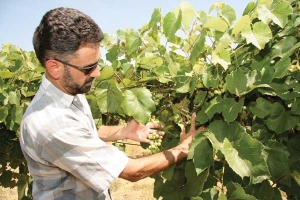
Dr. Markus Keller shared the results of a high-density spacing trial in juice grapes with growers attending a summer field day.
High density often translates into higher production in tree fruit, but in Concord juice grapes, Dr. Markus Keller has found that the opposite occurs.
Although a high-density grape planting (defined as three feet between vines) is productive at first, wider spacings (with 6, 9, or 12 feet between vines) produce more grapes per acre after the initial years. He also observed a stark difference in berry composition, with high pH levels in the high-density berries.
“Here’s the catch: the high-density vines produced more in the first four years of planting, but in the last three years, they’ve produced less per acre than the six, nine, or twelve-foot spacing vines,” he said, adding that average was 14 tons in the 6 to 12 foot spacing compared with only seven to nine tons at the three-foot spacing. “There’s a huge difference between three feet and six feet.”
Keller is studying the establishment and performance of Concord grapes planted at various distances both within and between vineyard rows as a way to maximize crop production while maintaining desirable fruit quality. Narrow spacing of wine grapes is widely used in Europe to impose competition in the plant and decrease vigor, he noted.
But when such spacing is applied to Concord grapes, the tight spacing creates large, dense canopies and the vines compete for light, not water, Keller said. “With high density in Concords, now you have dense canopies with long shoots, big leaves, and you have a smaller ratio of surface-to-fruit volume in the canopy. You lose a lot of flowers that never set fruit because they are inside the canopy.”
High-density juice grapes averaged two clusters per shoot compared with three to four in the six-foot and wider spacings.
“There’s too much shade, too big a canopy, and you’re hurting the fruitfulness for this year and next in the high density,” he said.
The fruit in the closer spacings have higher pH levels because the yellow leaves inside the three-foot canopies are recycling nutrients back into the fruit, he explained. “When potassium in the leaves is mobilizing into the clusters, it shoots the pH levels way up.”
Growers should be cautious about narrow spacing in juice grapes, as yields will be impacted, he said. “In the end, we may be coming back to the industry standard of six- by nine-foot or nine- by nine-foot spacings, although we don’t know yet what the long-term effect of twenty to forty years may be. But so far, six by nine is working just fine.”

Leave A Comment